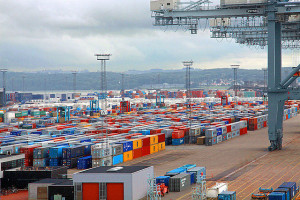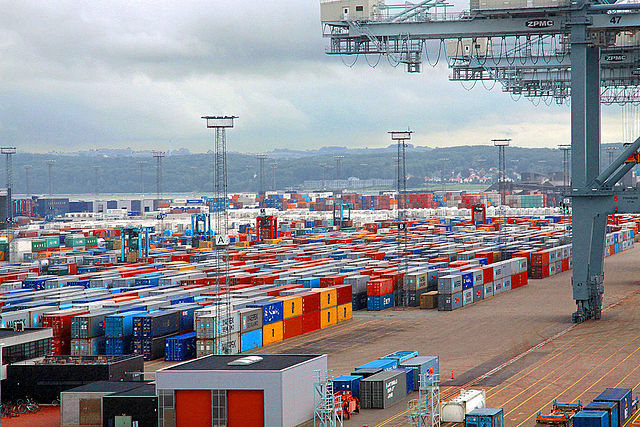 A new study suggests that the economies of scale being derived from mega container ships are fast reaching their peak in terms of benefits to the industry, with additional gains likely to diminish unless all industry stakeholders collaborate closely on improving productivity.
A new study suggests that the economies of scale being derived from mega container ships are fast reaching their peak in terms of benefits to the industry, with additional gains likely to diminish unless all industry stakeholders collaborate closely on improving productivity.
Global shipping consultancy Drewry said it has carried out a simulation study of the operational and financial impacts on lines, terminal operators, ports, and other supply chain stakeholders as vessel size increases up to and beyond 18,000 TEUs.
On a total “system cost” basis, the study found that the upsizing of vessels provides only modest savings for the overall supply chain, with efficiency gains being further eroded as vessel size increases beyond 18,000 TEUs, it added.
It said that since 2009, container shipping lines have engaged in a newbuild “arms race” with vessel sizes increasing at breakneck pace to drive down unit costs and improve profitability.
This race-to-scale is set to continue with a further 53 mega ships expected to enter service in 2016.
While bigger ships help carriers reduce voyage costs, these savings are increasingly offset by higher port and landside costs, meaning that total system cost savings are small and declining.
“Larger vessels place greater demands on ports, where channels have to cater for deeper draughts and on terminals, which need to upgrade equipment, yard facilities and manning levels to effectively handle increased peak cargo volumes,” said Drewry.
It expects that even with no further increase in maximum vessel size, the sheer number of mega vessels expected to be delivered in 2016 will strain terminal resources, as the average size of ships increase the amount of cargo that has to be handled at times of peak container activity.
Among key findings of the study is that combined shipping line and port “total system” cost savings peak at only 5% of total network costs, and economies of scale diminish as vessel sizes rise beyond 18,000 TEUs.
Moreover, terminals will incur significant capital expenditure to handle larger vessel sizes and terminal yard areas will need to increase by one third to avoid congestion, even with no growth in volume.
Also, scale economies from mega ships only work for the total supply chain if terminals can increase productivity in line with increases in vessel size.
At the same time, Drewry warned that continued vessel upsizing risks could lead to no significant cost benefit, lower service frequency and/or less choice for shippers, higher supply chain risks as volumes are concentrated in fewer vessels, and environmental effects arising from dredging deeper channels and expanding yard area.
“As more megaships enter service the industry is rapidly approaching a critical stage,” said Tim Power, managing director of Drewry. “To ensure the economics of vessel upsizing continue to benefit the entire supply chain, lines and ports need to work in a more coordinated manner if further productivity improvements from the transport system are to be realised.”
He added that a cross-industry effort is needed to address the operational and cost effects at port facilities caused by the challenging load and discharge patterns of these larger ships.
“All stakeholders in the supply chain must recognise the need for dialogue and collaboration if the maritime transport system as a whole is to benefit. If these benefits cannot be delivered and economies of scale in this industry really are running out, the implications are profound.”
There is a wider possible implication of these findings for the industry: if economies of scale in liner shipping have finally run their course, future vessel ordering will no longer be driven by the need to secure economies of scale but will instead be based on lines’ assessment of future demand growth.
“When this happens, the tendency to structural overcapacity that has plagued the industry will be much reduced,” added Power. “If this were combined with a process of continuing industry consolidation, liner shipping might at last be in a position to generate sustainable profitability.”
Spot box rates plummet to new lows
Meanwhile, the World Container Index’s (WCI) composite index, an average of spot freight rates on 11 global East-West routes connecting Asia, Europe, and the US, reached a record low of US$701 per 40-foot container on March 10.
This is the lowest reading since the WCI started tracking weekly transatlantic, trans-Pacific, and Asia-Europe rates in June 2011, said the maritime advisory service.
Also on March 10, the index rate assessments for the Shanghai-Rotterdam and the Shanghai-Genoa routes fell to all-time lows of $354 and $341 per 40-foot box, respectively, while the latest Shanghai-Los Angeles rate of $878 per 40-footer was marginally higher than the record low for that route.
“The World Container Index’s composite index is now 60% lower than the average of the past 5 years and has decreased by 62% in the past year,” said Richard Heath, director of WCI.
Philip Damas, director at Drewry, which jointly owns WCI alongside Cleartrade Exchange, said: “Rate reductions are spreading across all routes, as the shipping market continues to soften. This is good news for shippers’ cost budgets, as the latest average index value of $701 per 40ft represents an expense of less than 10 cents per km and makes products competitive even in remote markets.”
Photo: Guillaume Baviere





